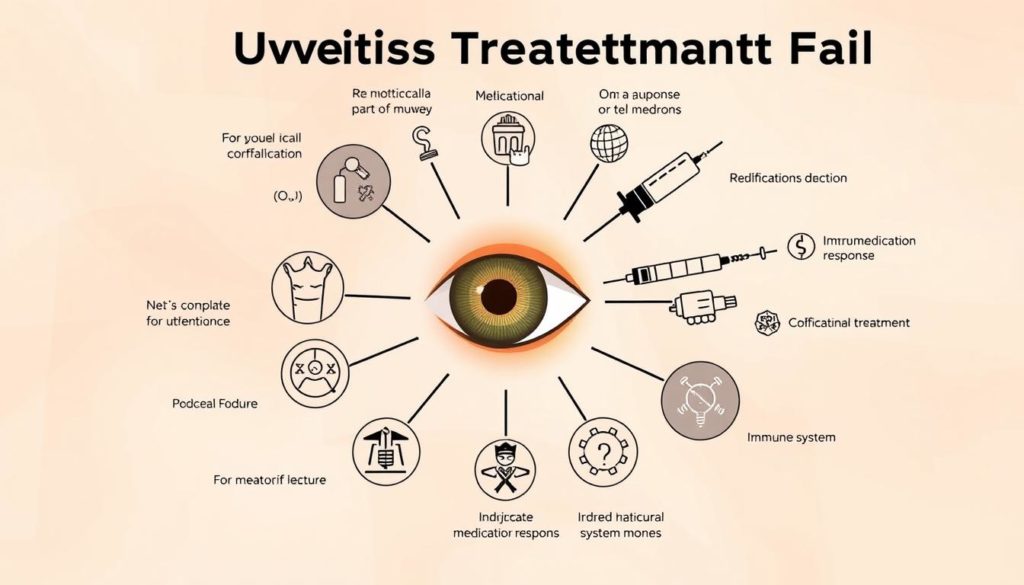“Success is not final, failure is not fatal: it is the courage to continue that counts.” – Winston Churchill
When the first treatment for uveitis doesn’t work, it can feel really tough. But, there’s hope. Knowing what to do next is key to managing this eye issue well. By learning about uveitis treatment guidelines and the best options, you can move forward with hope and strength.
Let’s explore what happens when treatment fails and how to take back control of your health.
Understanding Uveitis Treatment Failure
Uveitis treatment can be complex. Knowing why some treatments fail is key to managing it well. Several factors can lead to treatment failure. Identifying these early helps in finding the right management strategies.

Common Reasons for Treatment Failure
Finding out why treatments fail is the first step to managing uveitis. Common reasons include:
- Inaccurate Diagnosis: Misdiagnosing uveitis or missing underlying conditions can make treatments ineffective.
- Medication Inefficacy: Some medications don’t work for everyone, so alternative treatments are needed.
- Patient Non-adherence: Not following the treatment plan consistently can make management ineffective.
Identifying Symptoms of Treatment Resistance
Knowing when treatments aren’t working is vital for timely action. Signs of treatment resistance include:
- Persistent eye pain and redness despite ongoing treatment.
- Continuous or worsening vision problems.
- Frequent flare-ups or relapses of uveitis symptoms.
Spotting these symptoms early helps in talking to healthcare providers about changing management strategies.
Immediate Steps to Take When Uveitis Treatment Fails
Act quickly if your uveitis treatment isn’t working. This can stop things from getting worse and help find better treatments. Here are the first steps to take when treatment fails.
Consulting with Your Ophthalmologist
See your ophthalmologist right away if treatment isn’t working. They will check your eyes to see how you’re doing. They might change your medicine or try something new.
Tell your ophthalmologist about any new symptoms. This helps them understand what’s happening and what to do next.
“Open dialogue with your ophthalmologist allows for a better understanding of why your current treatment may be failing and what steps to take next.” — American Academy of Ophthalmology

Reassessing Your Diagnosis
If your symptoms don’t get better, it’s time to look at your diagnosis again. Uveitis can be linked to other health issues. Your doctor might do more tests to make sure you’re getting the right treatment.
Looking into other treatment options and talking to a specialist can help. When usual treatments don’t work, trying new things is important for your health.
Exploring Alternative Uveitis Treatment Options
When traditional treatments don’t work, looking into other options is key. This part will cover advanced treatments and natural remedies that might help. They could improve your life and offer relief.
Biologic Therapies
Biologic therapies are new and promising. They aim to reduce inflammation by targeting the immune system. Medications like Humira and Remicade have helped many with severe uveitis.
Immunosuppressive Medications
Immunosuppressive drugs are another option. They calm the immune system to fight uveitis. Drugs like methotrexate and cyclosporine are effective but need close monitoring.
Natural and Holistic Remedies
Natural remedies are a gentler choice. Eating foods rich in omega-3s and antioxidants can help your eyes. Acupuncture and herbs like turmeric also have anti-inflammatory effects.
| Uveitis Treatment Options | Overview |
|---|---|
| Biologic Therapies | Targeted therapies that modulate the immune system to reduce inflammation. |
| Immunosuppressive Medications | Drugs that suppress immune response to control uveitis. |
| Natural Uveitis Remedies | Holistic approaches including diet changes, acupuncture, and herbal supplements. |
Each option has its own benefits and can be customized for you. It’s important to talk to a doctor to find the best treatment.
When Uveitis Treatment Fails: Emotional and Psychological Impact
Dealing with uveitis can deeply affect your emotions and mind. The constant fight against the condition and the many times treatment doesn’t work can be very tough. It can lead to serious mental health issues that are often ignored. People facing these challenges need strong Uveitis patient support to get through the tough times.
Understanding the Uveitis treatment psychological impact means seeing the wide range of feelings patients might have. They might feel frustrated and hopeless because of the symptoms coming back. They worry about their vision long-term, adding to the emotional burden. Talking to mental health experts who get chronic illness is very helpful.
It’s also key to have a full support system. Regular visits to doctors, joining groups for support, and counting on family and friends are vital. These help a lot in improving life quality for those with uveitis.
“Living with uveitis can be an overwhelming journey. It’s crucial to address the emotional and psychological impacts alongside the physical symptoms. Having a robust support system can make all the difference.” – American Academy of Ophthalmology
Lastly, building a strong mindset helps patients deal with ongoing treatments. It’s about being kind to yourself, setting achievable goals, and celebrating small wins. When treatments fail, the future might seem hard. But with the right emotional support, patients can find the courage to keep going.
Newest Advancements in Uveitis Treatment
New discoveries in uveitis treatment are giving hope to patients and doctors. These new findings are changing how we treat the condition.
Latest Research and Breakthroughs
Recent uveitis treatment advancements have improved our understanding and treatment of the disease. Research in journals like the “Journal of Ophthalmology” shows new therapies. These therapies target the immune system better, causing less harm.
Breakthroughs include the use of adalimumab and infliximab. These drugs are helping patients who don’t respond to usual treatments. This is a big step forward in uveitis treatment breakthroughs.
Gene therapy is also being researched. Scientists at places like Johns Hopkins are looking into how genes can stop uveitis from getting worse. This could be a long-term solution for patients.
Clinical Trials to Consider
Many clinical trials are looking into new ways to treat uveitis. For example, the NIH is testing new drugs that could help symptoms last longer.
Here’s a look at some key trials:
| Study | Institution | Focus | Status |
|---|---|---|---|
| IMM-203 Trial | NIH | Immune Modulating Drugs | Ongoing |
| GENE-U01 Study | Johns Hopkins University | Gene Therapy | Recruiting |
| BIO-AD 2 | Cleveland Clinic | Biologic Agents | Completed |
By joining these trials, patients get to try new treatments. They also help make treatments better for everyone in the future.
Combining Treatments for Better Outcomes
Looking into different uveitis treatment strategies can really help manage this condition better. Mixing various treatments can lead to better results for patients.
Using a multi-modal approach often helps control uveitis better. It combines the best of each treatment for the best results.
By mixing these strategies, we make sure each treatment’s strengths help out the other’s weaknesses. This is key in dealing with the complex nature of uveitis. Here’s a look at some combined treatment methods:
| Treatment Combination | Benefits | Challenges |
|---|---|---|
| Corticosteroids + Immunosuppressives | Quickly reduces inflammation and lowers long-term side effects | Needs close watch for immune system effects |
| Biologic Agents + Immunosuppressives | Effectively targets autoimmune responses | May increase infection risk and needs regular blood tests |
Effective uveitis management often means customizing these combinations for each patient. Everyone reacts differently, so what works for one might not work for another. It’s important to work closely with a healthcare provider to find the right mix of treatments.
In summary, using these combined uveitis treatment strategies can greatly improve patient outcomes. It offers hope for those who haven’t seen results with traditional therapies. By understanding and using these multi-faceted approaches, we can make big strides in managing uveitis effectively.
Frequently Misdiagnosed Conditions Related to Uveitis
Uveitis is a complex inflammatory condition. Many other diseases are often mistaken for it. It’s important to do a thorough diagnosis to get the right treatment.
Other Autoimmune Diseases
Autoimmune diseases can look like uveitis. This includes conditions like rheumatoid arthritis, lupus, and sarcoidosis. They can cause eye inflammation similar to uveitis. It’s key to tell them apart for the right treatment.
Infectious Causes Mistaken for Uveitis
Infections like tuberculosis, syphilis, and herpes simplex virus can also be mistaken for uveitis. They can cause eye inflammation that looks like uveitis. Finding the cause is crucial for proper treatment.
| Condition | Key Symptoms | Uveitis Differential Diagnosis |
|---|---|---|
| Rheumatoid Arthritis | Joint pain, swelling, eye inflammation | Blood tests for rheumatoid factor, imaging studies |
| Lupus | Butterfly rash, photosensitivity, eye inflammation | Antinuclear antibody test, complete blood count |
| Tuberculosis | Chronic cough, weight loss, night sweats, eye inflammation | Tuberculosis skin test, chest X-ray |
| Syphilis | Sore throat, fever, rashes, eye inflammation | Blood test for syphilis, lumbar puncture |
| Herpes Simplex Virus | Blister formation, pain, eye inflammation | PCR testing, viral culture |
Developing a Personalized Uveitis Management Plan
Creating a tailored uveitis management plan is key for handling this complex condition. Each patient’s journey with uveitis is unique. So, their treatment strategy must be too. Let’s explore the steps to create a comprehensive care strategy and why ongoing monitoring and adjustments are crucial for the best results.
Creating a Comprehensive Care Strategy
To create a comprehensive care strategy, we must consider several factors. These include the type of uveitis, how the patient has responded to treatments before, and their lifestyle. A broad-spectrum approach might include:
- Detailed Medical History Review: Understanding the patient’s past medical records.
- Customized Medication Plan: Prescribing biologic therapies or immunosuppressive medications.
- Lifestyle and Dietary Adjustments: Incorporating nutrition and holistic remedies to complement medical treatments.
Monitor and Adjust Treatment Regularly
Regular monitoring and timely adjustments to the treatment plan are crucial for managing uveitis effectively. Emphasizing the need for continual assessment helps in recognizing treatment resistance early. This allows for quicker intervention. Consider the following:
- Frequent Check-ups: Scheduling consistent follow-ups with the ophthalmologist.
- Symptom Tracking: Maintaining a log of any new or recurring symptoms.
- Flexible Treatment Plans: Adapting medication dosages or exploring alternative therapies as needed.
By focusing on uveitis personalized management and consistently adjusting uveitis treatment, patients can better control their condition. This improves their quality of life. This ongoing, dynamic approach ensures the management plan evolves with the patient’s needs and the progression of uveitis.
Support Systems and Resources for Uveitis Patients
Living with uveitis can feel really tough. But, having strong uveitis patient resources and uveitis support systems can really help. Connecting with the right groups and organizations can give you the support you need to handle the condition well.
Support Groups: Being part of support groups is a great way to meet others who understand what you’re going through. These groups offer emotional support and useful tips, helping you better manage your condition.
Educational Materials: Using educational materials like brochures, online articles, and videos can really help you learn more about uveitis. These resources give you the latest info on treatments and ways to cope.
Advocacy Organizations: Groups like the American Uveitis Society and the Ocular Immunology and Uveitis Foundation are key in helping uveitis patients. They provide important uveitis patient resources, support research, and work towards better treatments.
| Resource Type | Description | Benefits |
|---|---|---|
| Support Groups | Communities for sharing experiences and solutions | Emotional support, practical advice |
| Educational Materials | Brochures, articles, videos | Enhanced understanding, up-to-date information |
| Advocacy Organizations | Groups like the American Uveitis Society | Patient advocacy, research funding |
By using these uveitis support systems in your care, you get the tools and support you need to deal with uveitis. Remember, you’re not alone. There are many resources ready to help you every step of the way.
Nutrition and Lifestyle Changes to Support Uveitis Treatment
Managing uveitis goes beyond just doctor visits. Adding nutrition for uveitis patients and lifestyle changes to your daily life can greatly improve your treatment. Eating foods that fight inflammation, like leafy greens and fatty fish, is key. Also, include foods rich in omega-3s, vitamins A, C, and E, and antioxidants.
It’s also important to make lifestyle changes for uveitis. Stress management, like yoga and meditation, can help prevent flare-ups. Regular exercise boosts your immune system and improves your health. Quitting smoking and cutting down on alcohol also helps protect your vision and speeds up recovery.
Staying hydrated and getting enough sleep are also crucial. Drinking water keeps your body fluids balanced, which is good for your eyes. Getting enough sleep helps your body repair and grow. By focusing on nutrition and lifestyle changes, you can make your treatment more effective and improve your eye health.
FAQ
What are some common reasons for uveitis treatment failure?
Uveitis treatments can fail for many reasons. These include wrong diagnosis, medicines not working, or patients not following treatment. Knowing these reasons helps in managing the condition better.
How can I identify symptoms of treatment resistance in uveitis?
Signs of treatment resistance include ongoing inflammation and vision getting worse. If you see these signs, talk to your eye doctor right away.
What immediate steps should I take when uveitis treatment fails?
If treatment isn’t working, see your eye doctor first. It’s also important to check if your diagnosis is correct for your uveitis type.
What are some alternative uveitis treatment options?
Other treatments might include biologic therapies and natural remedies. Always talk to your doctor about these options to find the best treatment for you.
How does uveitis treatment failure impact mental health?
Failure in treatment can affect your mental health. You might feel frustrated, anxious, or depressed. Getting support from therapy or support groups can help.
What are the latest advancements in uveitis treatment?
New treatments include biologic drugs and research breakthroughs. Keeping up with these advancements can lead to better management options.
Are there benefits to combining different uveitis treatments?
Using different treatments together can work better. This multi-modal approach can improve how well you manage uveitis.
What conditions are often misdiagnosed as uveitis?
Other diseases can look like uveitis. Getting the right diagnosis is key to effective treatment.
How can I develop a personalized uveitis management plan?
To create a plan, tailor treatments to your uveitis type. Monitor how you respond and adjust as needed. A detailed plan is essential for managing uveitis well.
What support systems and resources are available for uveitis patients?
There are many resources like support groups and educational materials. These can offer support, information, and a sense of community for those with uveitis.
What nutrition and lifestyle changes can support uveitis treatment?
What you eat and how you live can help manage uveitis. Eating well, exercising, and reducing stress can support your treatment and improve your health.


